Video games and the change of autumn
The golden browns of The Vanishing of Ethan Carter, The Last of Us and Fallout 4.
Editor's note: Rob's piece here concludes his series of essays for Eurogamer on the seasons in video games. For more, be sure to check out Video games and the life of summer, starring Witcher 3, Firewatch and Dishonored 2, The power of spring in Horizon Zero Dawn, Everybody's Gone to the Rapture and The Last of Us, and Video games and the power of winter, which looks at Skyrim.
Rain and wind, shorter days, and imminent dormancy; autumn often has a bad reputation. However, there is excitement, intrigue and pleasure to be found in this season of change. Landscapes become sparser with each leaf that drops in the wind. The temperature oscillates between a gentle warmth and a sharp chill. Golden foliage changes the colour of the land and alters the feel of the landscape.
Some games have wondrous, gorgeous autumn landscape that present supreme autumnal palettes, narrative-mirroring landscape conditions and encapsulate the mysterious change that hangs in the air.

Autumn's transitional nature enables it to offer different aesthetics and atmospheres - perfectly encapsulating our often-mixed feelings about the season. This flux occurs in games, too: storyline changes; mysterious plotlines, character and atmosphere intricacies; constant environmental transformations; and a powerful sense of mystery, story-foretelling and landscape-opening are all harnessed to be used as game-changing devices.
The Vanishing of Ethan Carter begins with a long tunnel that almost feels like a big-reveal set up and release is coming, but instead autumn-coloured ripples appear, revealing Red Creek Valley. The autumn mist floats through our vista and the low-angled autumn sun casts a mysterious light straight at Paul through landscape - this seems to highlight the land's features and plants, but also him and his place in it. Paul says this is his last case, so there's a direct link between his immersion in, and exploration of, an autumn landscape, in the autumn of his career.
Just before, and as the ripples present the landscape, Paul already seems to know the mystery and unsettled nature of Red Creek Valley and its darkness. He feels its darkness reaching and he already knows he has to "figure out what this place is trying to hide from me" - the mysteries of an autumn landscape, caught in transition and change. Continuing to anticipate and understand the autumn landscape early on, Paul attempts to get a hold on its curious, autumnal sense of place: "Red Creek Valley. Seemed like a quiet, ordinary place. But if there's one thing I've learned it's that no place is truly quiet, and nowhere is really ordinary."
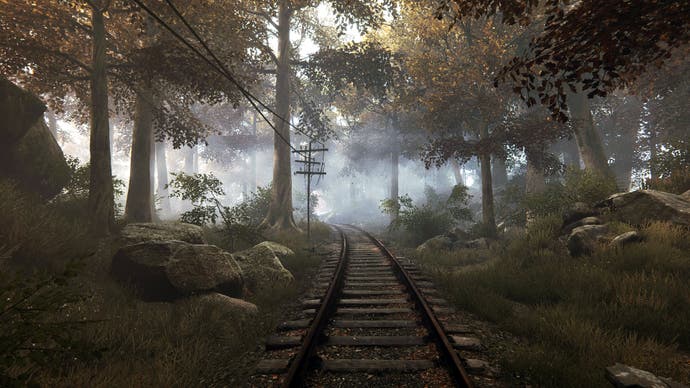
Autumn's effect on landscapes enhances and supports this approach - that of mystery, hiding, change and the obscurities of memory and imagination. Due to its transient nature between more-definite seasons, as its foliage slowly but surely covers the ground, but hangs to just about enough foliage to cover its bones, changing the palette of both the ground plane and higher. The autumn landscape feels like it has an openness: an emptiness - but not that of winter; but also, a strong element of life and endurance - but not that of summer. Slowly shedding tree limbs, and ever-barer soil adjacent to small flowering plants and tufty grasses highlight this tension between the two states and the caught-in-the-middle mystery of autumn that beautifully complements Ethan Carter's landscape.
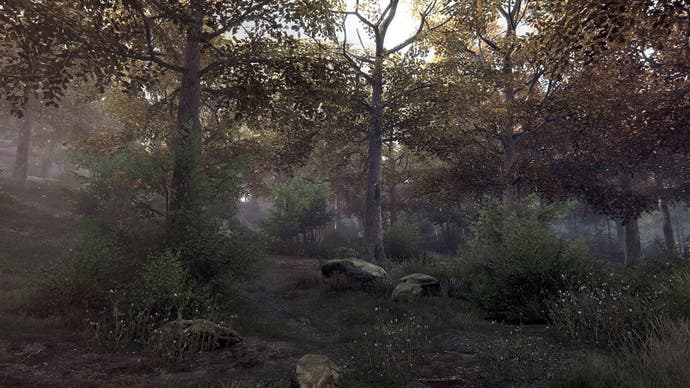
Paul's intermittent commentary often relates to the autumn landscape and acts as a successful and powerful connection between it and the plot. Towards the beginning of the story Paul passes the train stop and describes the land around him: "...Large pieces of this country were thrown away, doomed to become, and then remain, the worst versions of themselves. Beneath all that rot, dark things grow."
This is an evocative and literal description of the landscape: the land seems a bit thrown away and left to its own devices; the properties visible farther down the tracks are abandoned, tossed aside; even the huge man-made structure of the dam is encroached upon by atmospheric mist and is showing signs of being battered by autumn weather; and the overarching umbrella of autumn is turning the land dormant, turning its veneer into mulch, decaying plant life, and golden-leaved tree foliage. However, the description - enhanced by the landscape - seems to reflect Ethan's imagination being compromised, not entertained, and eroded by the cold shoulder he often receives from his family. Perhaps enough neglect and hardness can cause dark thoughts to grow inside of Ethan, much like Paul describes the landscape with "under all that rots, dark things grow".

However, there are more tangible and clear autumn characteristics to The Vanishing of Ethan Carter's landscape. There are physical elements and features of the landscape that display the season without ambiguity and appeal to our attraction and affiliation with autumn through obviously autumnal manners. Specifically, in this landscape the most prominent physical element is the trees, particularly the deciduous ones: they are obviously autumnal, with their golden tones and their falling foliage. More generally, there is a believable and pleasing mix of both deciduous and evergreen trees from birches to pines, but it is the golden, broad-leaved trees that are the most prevalent and also the most autumnal. These are Acers, or maple trees. Given the temperate USA setting, the most common autumn deciduous tree in the landscape is probably Acer rubrum (the red maple). This is usually the first to show that autumn is just around the corner with its own habit of changing colour: one or two branches turn yellow or orange-red, then another branch follows, and then another. This trait, of branches showing their autumn finery a few at a time while the rest of the tree stays green, is a relatively unusual one. It constantly marks this tree out from its companions - who usually don their autumn coats all at once, in one swift movement - making it a very attractive, instantly-autumnal specimen. Another reason why it is so prevalent across Ethan Carter's landscape is that it can also tolerate varying light levels, giving it a huge advantage in forest settings such as parts of Red Creek Valley. It is very much the autumn tree - using a broad brush.

Symbolically the tree finds itself at home in Ethan Carter, too. Like many trees, the maple has its own various meanings, background and cultural significance, spread across time and geography. In centuries gone by across English-speaking countries the maple tree was believed to repel demons and evil spirits. Elsewhere, it was seen as a tree of practical magic and tolerance; the former very much vividly represented in Ethan's imagination and the latter rather contrasting the lack of tolerance Ethan feels from his family.
Aside from the maple trees themselves and the role they can be seen to play specifically, the general aesthetic of Ethan Carter's autumn woodland is redolent of a northern hemisphere, temperate landscape undergoing autumn's change. The mix of plant life and tree types is excellent and creates an accurate colour palette as well as landscape texture. From the pine trees providing year-round structure, to the golden deciduous maples, to the low growing brushier grasses and the small pops of colour on herbaceous all set off by a landscape worn down over time, showing the effects of yet another autumn through exposed rocks, bare patches of earth and debris. This kind of deeply autumn landscape is thick with atmosphere, but even the small things, like Paul's footsteps on the land - which can almost be 'felt' and heard as soft, but not soggy, patters on the autumnal land - crunching and padding his way through leaves, needles, mosses and debris, make for an immediately relatable sound and feel to the journey.

The Vanishing of Ethan Carter's autumn setting is incredibly effective and elevates the sense of escapism, imagination and mystery that permeate throughout the story and Paul's experience. The change autumn brings creates a Red Creek Valley thick with atmosphere and sense of place, with a strong sense of mystery hanging over it, enhancing its themes. But, simply put, it is also a perfect setting as it is beautiful: a quiet, gorgeous landscape in which there is no need to rush. It can be enjoyed at a walking pace and absorbed as it provides a neat and appropriate backdrop to the game's narrative.
Much like the impact of the other seasons in The Last of Us, autumn is no different. However, it works two-fold in the game as we see two very different 'ends' of the season, leaving very different marks on the landscapes journeyed through by Joel and Ellie.
An early autumn setting with doggedly-persistent rain but with an almost-tangible mildness in the landscape's air greets the pair at the start of autumn's chapter. As with spring, autumn is known for its changeable whether - sandwiched between those more 'defined' and predictable seasons of winter and summer - and so this mix seems to make sense. Its effect on the landscape is fitting too: mild and wet weather is perfect for plants and can extend the growing season. So, despite the steady rain, there is lush foliage: a dense carpet and background of green ferns, pine, larch or spruce-looking trees yet to show any sign of autumn's really cold snaps - the downward bow in some of the branches is redolent of some spruces which stay green right through winter; the brushy grasses (not fading or bleached at all indicating early autumn); and low-growing, bushy and woody shrubs occasionally interrupted by colourful woodland plants. The damp, grey, but peaceful autumn landscape feels like an environmental sigh of relief after the drama of the suburbs and a nice, albeit, brief suspension of the frantic story and events. This autumn landscape is an interesting juxtaposition of the gorgeous surroundings with a usual but relentless weather type: the lush landscape providing positivity and beauty; the persistent rain raising awareness to the future.
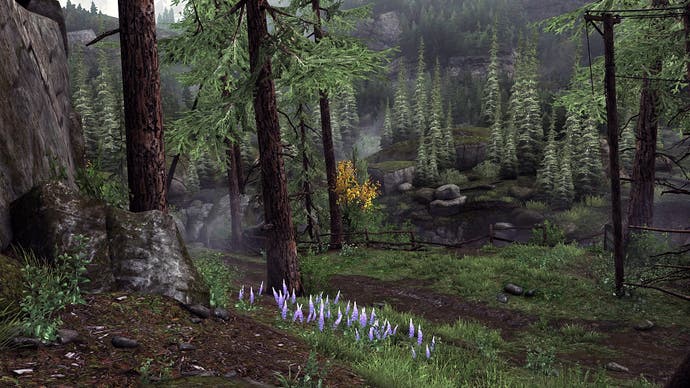
All things change upon reaching the university, however. A totally different look and feel is presented and significantly altered atmosphere hangs in the air and on the landscape, but it remains distinctly, and perhaps more recognisably autumnal - a late autumn aesthetic as opposed to the dam's early autumn. The contrast and execution of the portrayal of a dusky yet virescent evergreen autumn landscape changing into a crisp, golden and deciduous environment is exceptionally pleasing, but also accurate in its landscape features and feel. The change also mirrors the events of the story, with the ever-barer landscape, chilly air and even the sky getting darker over the course of the chapter, echoing the turn of events the chapter will bring.
At the university's landscape, man-made buildings, structures and roads re-appear and are once again smothered by plants; the landscape continuing its reclaiming mission, never really loosening its grip despite the seasonal change. However, the now-golden foliage shows the going-dormant and dying foliage in a beautiful range of oranges, yellows, reds and browns. While the colours are pleasing, the connection between the ever-sparser foliage and landscape, and the events of the end of the chapter seems close and distinct.
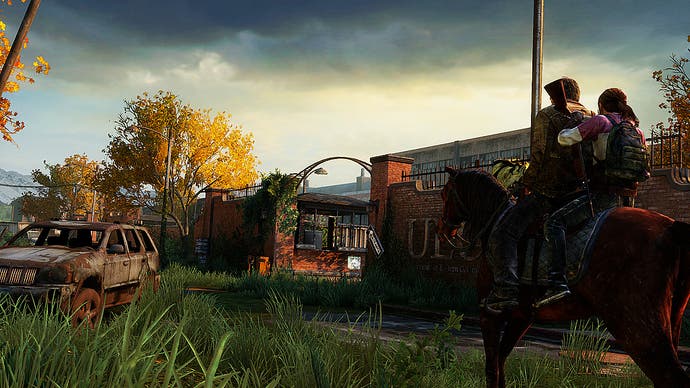
Across the university's landscape, however, it is no surprise to see the maple tree play an important role. Again, native to the setting, it would be prevalent across the area naturally, but also embraced and used as a landscape tree for features, focal points and general greening and softening of man-made areas. Using the tree here in the environment is also effective, believable and appropriate on a game-narrative level, beautifully and aptly accompanying it at this pivotal juncture.
Their golden colour makes a perfect backdrop to the hardness of the university's abandoned buildings and also heightens the contrast between the early and evergreen autumn aesthetic at the dam - the time of year, setting and plot have very much changed, and altering the land to a deciduous, golden and late-autumn landscape only serves to exaggerate that. The iconic autumn trees make for a distinctly recognisable autumn setting, immediately cementing the change that is on the land - and the plot. The red maples across the university are excellent specimens and authentically demonstrate the tree going through its autumnal motions. Perhaps, the tree's habit of changing gradually to its autumn colours, one branch at a time, almost mirrors Joel's slowly-but-surely changing attitude toward Ellie, his relationship with her and their journey.
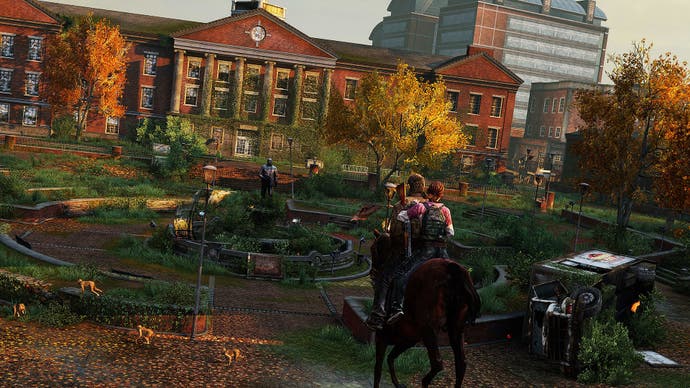
The tree's direct environmental role is powerful and prominent even within the university building itself, with autumnal landscape elements present, acting almost as fortune-tellers, continually displaying the importance of autumn's landscape in the chapter but also using the environment as a story-telling aid. A fine example of this is the autumnal tree leering into the building, extending the influence of the landscape into the in-game area - and the fact Joel and Ellie pass it once on their way in, and then again on their rushed escape on the way back out.
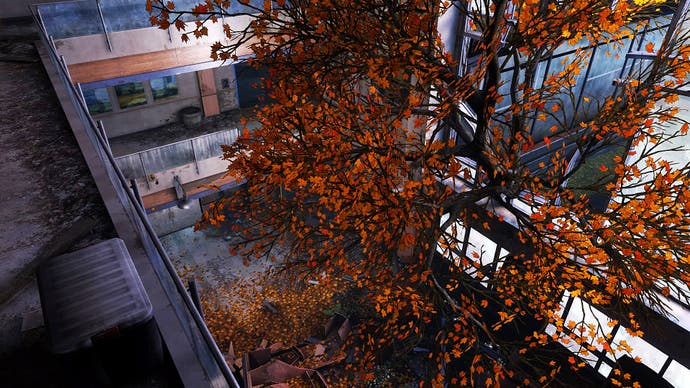
There is something powerfully autumnal about the season landscape representing the crushing of the characters' fortunes; and how Joel falls to a critical injury, landing on and being surrounded by the tree and its foliage - an element of the autumn landscape directly representing the dire situation, offset by the usually-pleasant colours of the landscape.
Autumn in The Last of Us is one of the most powerful uses of the season - and seasons generally - in games. The sense of change and transition is harnessed beautifully and encapsulates the plot movements and pace. It's quiet, early-autumn start crescendos into a dramatic late-autumn plot twist; the autumn landscape morphs from an evergreen version at the dam, to the auburn and golden deciduous, late-autumn one at the university, capturing the mood of the chapter and the characters, and the sudden downturn in Joel's fate.
The Commonwealth in Fallout 4 presents us with two very different autumn landscapes. In the prologue, we briefly see a bright, sunny and pleasant autumnal setting - the date the bombs dropped is set in the lore as 23rd October - filled with golden-orange trees, mist rising from the stream and a glowing warmth from the sun. An interesting use of the season of dormancy and the downturn of life in the landscape to reflect the dramatic downturn of the world as war forever changes landscapes and environments.
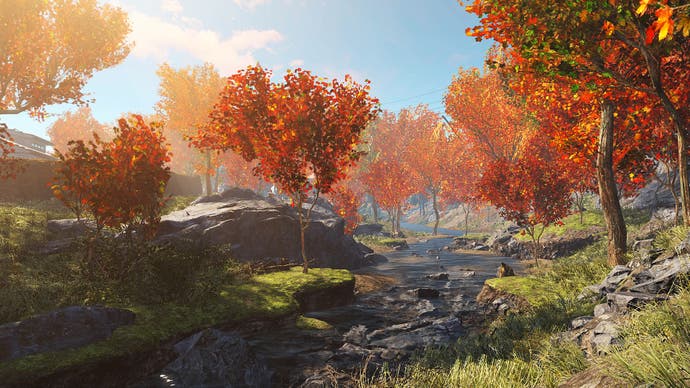
After the prologue and vault escape, the sole survivor finds their home landscape permanently altered. But in a strange, quasi-autumnal manner. While it was recognisably autumnal in the traditional sense when they left it, it has now been transformed into an almost totally-autumn-affected landscape. There is a constant tension in the landscape between dormancy and recovery and plants, topology, water sources and everything in between seems to be frozen in a 'perma-autumn' state. The result of this is a landscape that encapsulates the themes of autumn well - dormancy of life, semi-emptiness, end of life cycles and so on - and yet has a wide-open landscape allowing for clear vistas, and expansive autumn views through the land. The sun always seems low and glinting through the dead and dormant trees, there is a clear and distinct, but not wintry, emptiness to the land, and the prevailing colour palette is still in the orange, yellow, red and brown area of the spectrum.
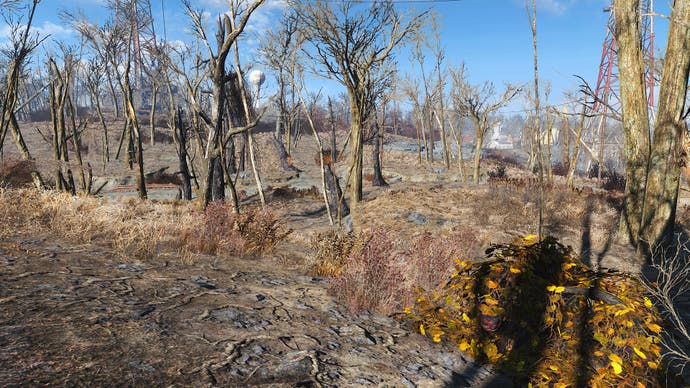
This landscape character is aided by the role the plants and soft landscape features play across the lands. There are little to no flowering plants or many with any real colour; the trees are all bare, near dead-looking; and the plants present are grassy, brushy and look like summer-thriving ornamental grasses that have gone over. Fitting in with the predominantly orange-colour theme, plants do make occasional pops of colour across the mostly-barren landscape, often in the form of brushier, grassier specimens. However, some more shrubby specimens make an appearance sporadically to provide structure and anchor points around trees in the landscape. What results is a strange, yet credible in an artistic licence-infused way, cross-sections of autumn from end to end as a season - almost encroaching into spring at times, and winter at others - but factoring in a distinct extra-environmental setting in terms of the nuclear devastation and fallout. What results is an autumnal feel to the landscape's softer elements as the sole survivor crunches their way past and through brittle-looking, golden plants and grasses and their debris, while often being able to utilise the season's ability to open up landscape vistas through the dormant and dead trees.
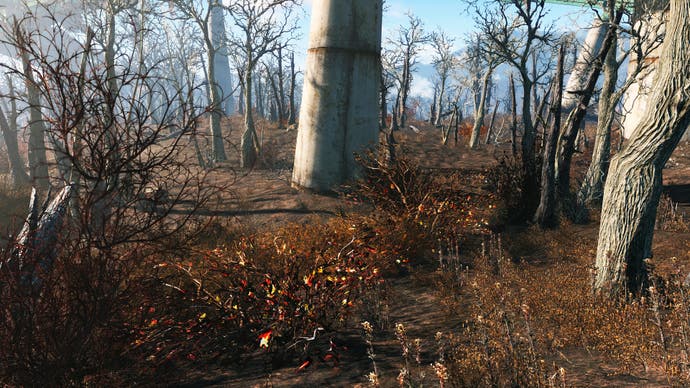
Of course, the time of year changes with days and weeks that pass in-game, but no matter what, and no matter the dated time of year, the landscape always feels autumnal. The landscape is littered with dormant-looking trees, autumnal-coloured plants and bare earth that culminate in a relentlessly autumnal landscape, constantly mirroring society's fall, desperation and struggle within the transient and changing nature of the season.
Autumn proves just as important in games' environments as the other seasons. It may not be as immediately impactful aesthetically as a snowy landscape or sunny, beach setting, but it can be equally important and manifests in games in its own powerful ways: changing atmospheres; altering landscapes before our very eyes; and twisting experiences. It neatly, pleasingly and intriguingly bridges the gap between the extremes of summer and winter, but with its own transient nature always present: each ray of gently warming sunshine offset by every dropping leaf; golden landscape trees provide immediately recognisable and powerful landscape sights; mystery enhanced by a landscape in constant change; vistas change, becoming more open; and the overall sense of dormancy and quiet emptying of the land proves a powerful narrative mirroring opportunity.

